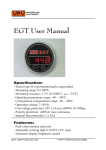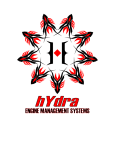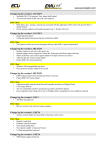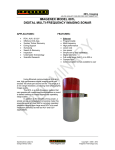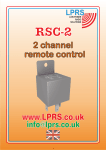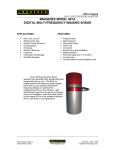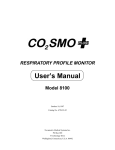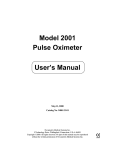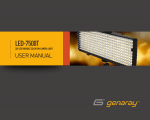Download LAMBDA 2 - PIILIx Automotive Electronics
Transcript
LAMBDA 2 USER MANUAL ©2012 VPV-Motorracing Electronics TABLE OF CONTENTS TABLE OF CONTENTS .........................................................................................................................2 1 TECHNICAL DETAILS..................................................................................................................3 1.1 General ...................................................................................................................................3 1.2 Technical specification ..........................................................................................................4 2 ASSEMBLY.....................................................................................................................................4 2.1 Sensor assembly .....................................................................................................................4 2.2 Display assembly....................................................................................................................5 2.3 Wire harness assembly..........................................................................................................6 2.4 Operating voltage and grounding .........................................................................................6 2.5 Warning light assembly and electrical connection ..............................................................7 3 OPERATION ...................................................................................................................................8 3.1 General ...................................................................................................................................8 3.2 Warning light adjustment......................................................................................................8 3.3 Interpreting the display value................................................................................................9 4. WARRANTY ...................................................................................................................................9 2 1 1.1 TECHNICAL DETAILS General VPV-Motorracing Electronics LAMBDA 2 is a single channel narrowband air-fuel-ratio gauge with Bosch 4-wire zirconium-type lambda sensor. Display is made using 16 superbright 5mm LEDs (colors red, red-orange, yellow-orange, amber, yellow and green) with automatic brightness control. Additional adjustable warning light included. Contents of the gauge set: -1 pc Display (1) -1 pc Bosch 0 258 005 730 or 733 lambda sensor (2) -1 pc Lambda mounting kit (3), (type may be various) -1 pc Ready-made wire harness (4) -1 pc Warning-LED (5) (available bezel colors: black, silver and gold) -1 pc 2-pole connector body for warning-LED (6) -10 pcs Cable tie (7) -1 pc User Manual (not in picture) Picture 1. Contents of the gauge set 3 1.2 Technical specification SENSOR: Manufacturer: Bosch-type: Part number: Type: Material: Wire count: BOSCH-USA LSH-25C or similar 0 258 005 730 or 733 Narrow-band Zirconium 4 DISPLAY: Measurement range (lambda-value): Current consumption (display): Current consumption (sensor heating): Operating voltage: Overvoltage protection: Polarity protection: Operational temperature: Material of the enclosure: Material of the front plate: Dimensions (width x height x depth): 2 2.1 0.75 – 1.20 200mA max 1-4 A 8.3-16V DC 24V 600W 10/1000μs 500V continuous -40°C-+70°C ABS 1mm polycarbonate 130 x 65 x 25 mm ASSEMBLY Sensor assembly Suitable assembly location for the sensor is in the front of exhaust system. Sensor can normally handle 400-800°C exhaust temperature and assembly should be made this in mind. Lifetime of the sensor is strongly affected by some abnormal situations and these must be taken into account when assembling sensor. - Hot sensor is easily broken if it is exposed to condensing water droplets. ’Clock 10:00-2:00’ is the best assembly location to avoid this. - Antilag systems or any other situation that causes fire in the exhaust system are harmful for the lambda sensors. In these situations it is recommended to assemble sensor further away from engine. Sensor positioning towards the end of the exhaust system can also help to prevent heat shocks to the sensor. - Sensor outer shell and wires should be protected from the flying stones or any other strong mechanical threat. - Sensor wires should be protected from the exhaust temperatures, 200°C max allowed. 4 In naturally aspirated engine the optimal sensor position is dependent on the type and dimensions of the exhaust manifold. Natural place for the sensor is the nearest position from the engine where the exhaust gases from all cylinders are thoroughly mixed. This location assures that the measurement value is the mean of the all cylinders. Example: 4-2-1 manifold equipped engine; best sensor position is 100-200mm from 2-to-1 transition toward the end of the exhaust system. In turbocharged engine the best location of the sensor is after the turbocharger. The exhaust gas pressure affects lambda sensor output voltage so the assembly before turbocharger is not allowed. NOTE! Antilag system may have strong effect on sensor lifetime, please look at the warnings and info earlier in this chapter. When assembling lambda sensors to motorcycles an additional care should be taken into account. Especially on 1-cylinder engine there are a strong exhaust flow pulsations. Strong pulses may cause the air to be sucked inside the exhaust system and this may cause static or pulsating error on measurement. Assembling sensor very near the engine exhaust port can minimize problem. When using lambda sensor together with small diameter exhaust pipe it may cause substantial flow restriction. This can be avoided by assembling sensor with a longer weld bung. This may cause a slightly slower reaction time but it doesn’t cause any static error. When assembling sensor the threads of the sensor should be lubricated with suitable high-temperature thread protecting paste. Without this paste the thread may be seized within a very short time. 2.2 Display assembly Natural assembly location for the display is inside the vehicle, normally on the instrument panel. Display is waterproof only on the front side so the assembly to wet location is not recommended. Fixing can be made using the M4 sized screws attached at the backside of the display unit. NOTE! Maximum depth screws can be inserted inside the enclosure is 7mm measured from the outer surface of the display back panel. Fixing can also be made using two-sided adhesive tape. If additional holes are needed for fixing, display should be disassembled before this to avoid any failures to the internal electronics. NOTE! Inside the display there are M4 sized riveted nuts for the fixing screws. If too much force is used for the disassembly of the M4 screws these nuts may become loose. If this happens the usage of the display is not allowed before loose nuts are removed or re-assembled. These loose nuts may cause permanent electrical failures to the display. 5 Picture 2. 2.3 Fixing screws at the rear side of the display Wire harness assembly Wire harness route should be chosen to avoid high temperature, sharp edges and strong electrical disturbance. Maximum continuous temperature the cable can withstand is 125°C, wire harness black silicone shield can handle 175°C. Display has good protection against electrical and magnetic fields but it is not recommended to route wire harness near ignition or alternator wires. Strong electrical or magnetic field may cause error to the measurement value. Male-type connectors can be disassembled without special tools to help wire harness routing, guidelines on picture 3. 2.4 Operating voltage and grounding Display is powered thru two power wires included in the ready-made wire harness: +12V = RED WIRE GROUNDING, -, GND = BLACK WIRE Grounding should be connected to a proper grounding point, alternative on chassis or in the engine. +12V should be connected to a low electrical disturbance point, absolute not directly to starter motor or alternator. Display has internal fuses to protect display and sensor heating. To protect power cables in wire harness it is recommended to connect a fuse to the feed of the display. Maximum current consumption is 4A and suitable fuse size is 5-10A To maximize sensor lifetime it is recommended that system get its power feed only when engine is running. 6 2.5 Warning light assembly and electrical connection Display has a separate warning light that can be mounted to a position where the driver has direct visibility to it. Warning light is a separate option module and it can be left unassembled without any effect on the behavior of the display. Warning light assembly hole is ∅ 16mm and assembly location material thickness can be 2-10mm. Warning light has a very narrow beam and it should be pointed directly towards the driver face for best possible visibility. Warning light connector is delivered loose to enable wire routing thru assembly hole. Because of the type of warning light (LED) wires should be connected with a right polarity, please look at table 1 below. Signal + / Anode - / Katode Table 1 Wire harness wire Blue Yellow Warning light wire Black Grey Warning light connection NOTE! NEVER CONNECT WARNING LIGHT DIRECTLY TO +12V VOLTAGE, IT WILL BE DESTROYED IMMEDIADLY! Picture 3. Disassembly of the connector 7 3 3.1 OPERATION General Display is ready to use, no calibration needed before use. 3.2 Warning light adjustment Warning light level adjustment trimmer can be found on the backside of the display. Adjustment is easiest made using flat screwdriver, size 3x 0,8mm max. Small Pozidriv or Phillips-type screwdriver is also suitable. When adjustment is at the most counterclockwise (CCW) position the warning light is OFF. Turned from this position to clockwise (CW) the warning level will change from lambda value 1.2 towards lambda value 0.8, in most clockwise (CW) position lambda-value warning level is 0.80. Warning light adjustment is linearly dependent on sensor voltage, because of lambda sensor output non-linear behavior the adjustment is not linear in lambda value. Please look pictures 4 and 5. Picture 4. Sensor output voltage as a function of temperature Picture 5. Warning light adjustment screw and approximate values 8 3.3 Interpreting the display value Because of the features of the narrowband lambda sensor exhaust gas temperature has some effect on measuring accuracy. Measuring error is mostly present on rich side of the measurement. Cold sensor gives higher output voltage; this means display shows richer reading than in reality. Display is constructed to be most accurate on high exhaust temperature; the situation normal in highly loaded racing engine. In Picture 4 you can see some approximately presentation about sensor output voltage vs. exhaust gas temperature. Normally naturally aspirated engine will give its maximum power when air-fuel ratio is about 10% rich (lambda 0.9) and best economy when air-fuel ratio is 10% lean (lambda 1.1). For the engine durability we are on the safe side when the air-fuel ratio is always on the rich side (lambda below 1.0). In addition to lambda value it is always good to check some other engine parameters to get the most power and reliability from the engine; exhaust gas temperature, spark plug color, knocking etc. During dynosessions etc. it is good to make some comparative study with wideband lambda gauges or exhaust analyzers to get idea about the actual lambda values in this particular assembly. 4. WARRANTY Display and wire harness has three (3) year warranty from the date of purchase. Normal wear and misuse is excluded from the warranty. Sensor is guaranteed to operate at the date of purchase, no further warranty. Sensor lifetime is strongly affected by the usage of it; manufacturer has no capability to control this and therefore no warranty can be granted. Possible engine failures or any other fails are on the responsibility of the user of the Lambda 2 measuring system. It is expected that the user have good knowledge of lambda measuring and engine tuning to avoid any failures, even in the case of sensor or display unit failures. 9









